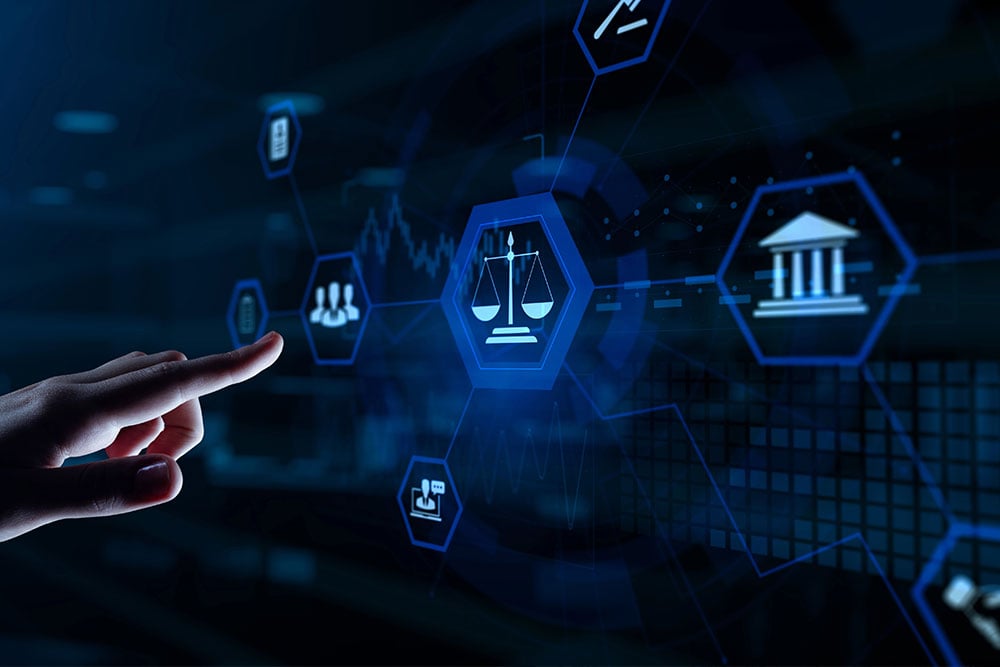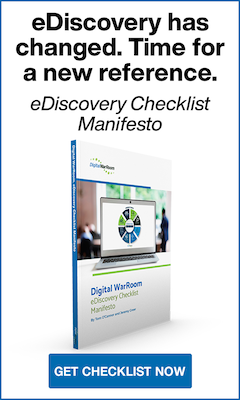When evaluating an eDiscovery platform, you’ll want to think across several key dimensions — not just features, but also workflow integration, security, and long-term value. Here’s a breakdown of the main considerations:
1. Core Capabilities
•Data Preservation & Ingestion:
Ensure the platform supports the output of common data sources (e.g., Microsoft 365, Google Workspace, Slack, Zoom, cloud storage, etc). Verify that it preserves metadata and supports a defensible collection.• Processing Power:
Can the platform handle large data volumes efficiently? Look for de-duplication, email thread identification, text extraction, OCR (for images/scans), and near-duplicate detection.
•Search & Filtering:
Assess advanced search capabilities (Boolean, proximity, fuzzy search) and support for complex queries. Good indexing performance is critical.•ReviewTools:
Evaluate how fast and intuitive the document review interface is — features such as tagging, highlighting, auto-redaction, privilege log support, and predictive coding (TAR) are key. For security and speed, avoid platforms that deliver whole documents across the internet for “local” viewing.•Production & Export:
Verify the platform supports secure, customizable exports in common legal formats (e.g., Concordance, Relativity load files, PDF, native).
2. Analytics & AI Features
•Early Case Assessment (ECA):
The ability to quickly triage large data sets to estimate case scope and cost.•Machine Learning / TAR:
Predictive coding, concept clustering, and AI analysis can significantly reduce review time. Be mindful of AI implementations that give LLMs access to sensitive client documents.•Language & Translation:
If you’re handling multilingual data, translation and language identification services are essential.• Email Threading & Communication Analysis:
Visualizations that show communication patterns help identify key custodians and conversations quickly. Grids identifying who is talking to whom (email and text frequency) about what (Boolean search overlays) are extremely useful.
3. Security & Compliance
• Data Residency & Privacy:
Consider where data is stored and processed. Ask what third-party machines and hosting services (Google, Azure, AWS, etc.) to avoid conflicts, address privacy obligations and data processor/sub-processor reporting requirements• Access Controls & Audit Trails:
2FA user authentication, threat monitoring capabilities, and detailed activity logs are essential for defensibility.
4. Cost & Scalability
• Pricing Model:
Understand whether costs are based on GB processed, hosted, or reviewed — and how those align with your case volume.• Online vs. Standby:
Determine if pricing the vendor offers reduced rates for offline or nearline storage when matters are in a quit period.
• Cloud vs. On-Premise:
Cloud solutions scale faster but may raise data sovereignty concerns; hybrid options can offer balance. Look for solutions that can provide both a hosted solution as well as a compatible standalone on-premise license for long term use.
•Vendor Support & SLAs:
Evaluate support responsiveness, onboarding assistance, and uptime guarantees.5. Vendor Reputation & References
- Track Record:
Ask about use cases in your industry (especially if handling sensitive or government data). - References & Case Studies:
Speak with existing clients to understand performance in real-world scenarios. - Roadmap Transparency:
A vendor actively investing in AI and compliance features will better future-proof your selection.
Here’s a comparison matrix to help you evaluate Digital WarRoom (DWR) alongside a few major eDiscovery platforms (Relativity, Everlaw, Exterro). After the matrix, I’ll highlight where DWR tends to excel (or fall short) so you can see trade-offs more clearly.
|
Feature / Dimension |
Digital WarRoom (DWR) |
Relativity (One / On-Prem) |
Everlaw |
Exterro |
|
Deployment / Architecture |
On-premises (desktop “Pro”) or hosted (cloud) versions. Digital War Room+3Digital War Room+3Digital War Room+3 |
Primarily cloud (RelativityOne) or on-premises in many legacy installations |
Cloud-native (SaaS) |
Mostly cloud / hybrid (with strong integration into governance modules) |
|
Licensing / Pricing Model |
DWR Pro (desktop) license + hosted subscriptions; “Single Matter” hosted model (monthly) and “Private Cloud” firm-wide option. No processing fees in some tiers. Software Advice+3Digital War Room+3Digital War Room+3 |
Often modular pricing (per user, per GB, add-ons) and high fixed costs; Relativity is known for relatively expensive licensing |
Subscription / usage pricing. Reviewers often cite more predictable pricing and lower overhead for mid-sized matters. GetApp+3Everlaw+3Everlaw+3 |
Bundled with governance, risk, and compliance tools; pricing can get complex due to added modules |
|
Data Processing & Ingestion |
Drag & drop import, automatic extraction of metadata, indexing, deduplication, etc. Digital War Room+3Digital War Room+3Digital War Room+3 |
Strong processing engine, broad connector support, large scale performance |
Fast processing, good automation, strong throughput claims (Everlaw touts very high throughput) GetApp+3Everlaw+3Everlaw+3 |
Good ingestion, especially for enterprise / governance data sources (e.g. integration with information governance) |
|
Search, Analytics & AI / ML |
Filtering, keyword search, “Who to Whom (About What)” heatmap, ad hoc search, find-similar features, near dupe detection. Best Legal Discovery Software+3Digital War Room+3Digital War Room+3 |
Strong search, clustering, analytics, TAR / predictive coding modules |
Very strong in analytics, AI, visualizations, user experience in querying & exploration Everlaw+2Info-Tech Research Group+2 |
Strong in governance / compliance analytics, risk scoring, integrating with ERM / IG modules |
|
Review & Marking / Tagging |
Custom marking, issue codes, privilege designation, redactions, intuitive right-click “mark” workflows. Digital War Room+3Digital War Room+3Digital War Room+3 |
Rich review environment, lots of customization, large user base |
Clean UI, fast document-to-document transitions, positive user praise for review speed & usability Info-Tech Research Group+3Everlaw+3Everlaw+3 |
Good review tooling; sometimes users say the workflow is more oriented for governance than pure litigation review |
|
Production & Export |
Bates numbering, image / native exports, configurable productions. Digital War Room+2Digital War Room+2 |
Very advanced production options, load files, redactions, custom formatting |
Strong production support, often praised for usability in producing to opposing parties Everlaw+2Info-Tech Research Group+2 |
Good export / production, especially when integrated with governance policies and retention rules |
|
Legal Hold / Preservation |
More modest compared to large vendors; focused on core discovery (though some hold features exist) |
Strong hold / preservation capabilities especially in enterprise stacks |
Includes hold / preservation features; good integration with review workflows |
One of Exterro’s strengths is its legal hold / preservation / information governance stack G2+1 |
|
Security, Certifications & Compliance |
Security protocols, malware monitoring, independent audits, breach notification. Digital War Room |
Broad enterprise-level compliance certifications, mature security controls |
High security, multi-tenant cloud with strong vendor practices |
Strong enterprise focus, often integrated with governance compliance and audit controls |
|
Scalability & Performance |
Suitable for small–medium and mid matters; for very large enterprise scale may hit limits compared to big vendors |
Excellent scalability for very large datasets and enterprise deployments |
Very good in scale; many users cite it handles high volume data sets effectively |
Tailored for enterprise scale, especially in integrated governance environments |
|
User Experience / Learning Curve |
More lightweight; users often appreciate its simplicity relative to heavy enterprise platforms |
Powerful but steeper learning curve for non-technical users |
Generally lauded for intuitive UI and ease of training / onboarding Everlaw+2Everlaw+2 |
More complexity (because of governance depth) — steeper in some modules |
|
Integration & APIs |
Decent integrations for core systems; may lack breadth compared to large platforms |
Extensive APIs, many third-party integrations, ecosystem partners |
Good integrations with cloud services, legal tools, APIs for extensibility |
Strong integration with enterprise systems (ERPs, GRC, IG, DLP, etc.) |
|
Support, Onboarding & Training |
DWR provides onboarding and training (including via screen share) as part of hosted subscriptions. ACEDS+2Software Advice+2 |
Strong partner / vendor ecosystem for training and support |
Strong vendor support and responsive teams; users often praise it |
Enterprise support, but sometimes slower to customize or respond depending on module complexity |
|
Cost / ROI |
Competitive for small-to-larger (10TB) matters; transparent per-GB pricing in tiers; on-prem version helps reduce ongoing hosting costs. Software Advice+3ACEDS+3Digital War Room+3 |
Cost can be high, especially in large-scale or complex projects |
Users often cite better cost predictability, lower overhead for medium cases |
Higher cost due to depth and modularity, but may offer value in combined governance + discovery use cases |
|
Strengths / Differentiators |
Best price, MS like UX, Easier entry, flexible licensing, DIY or full service hybrid, good balance of features for all but largest law firms and enterprises |
Robust enterprise capabilities, broad ecosystem, deep customization |
Excellent UX, modern architecture, AI / analytics features, fast adoption curves |
Best when you need integrated governance / compliance + discovery in one platform |
|
Potential Weaknesses / Risks |
May not match large Government or enterprise scale, breadth of connectors, or highly advanced AI modules |
Complexity, cost, steep learning curve |
Might lack some of the large scale/customization that legacy systems offer |
Can be overkill (and expensive) for simple litigation-only use cases; complexity |
- What should I look for in an eDiscovery platform?
- What is TAR (Technology Assisted Review) in eDiscovery?
- Is cloud-based eDiscovery secure?
-1.png?width=400&height=164&name=DWRLogoClassic%20-%20Copy%20(2)-1.png)









Comment On This Article